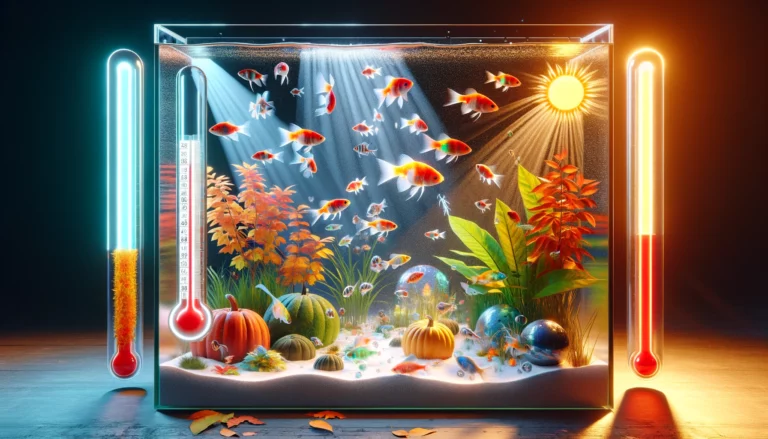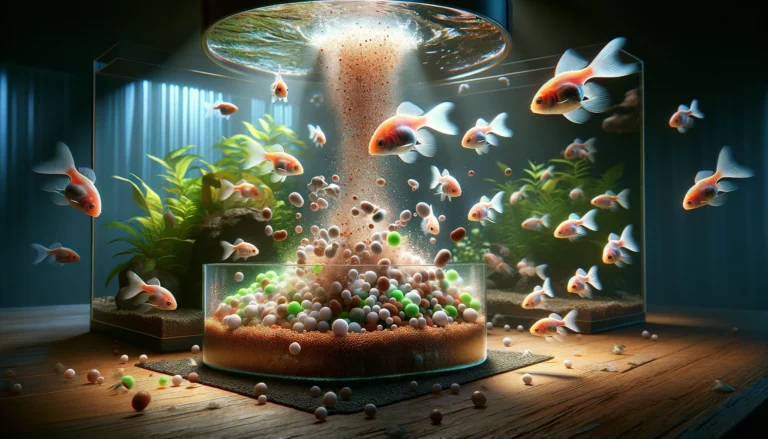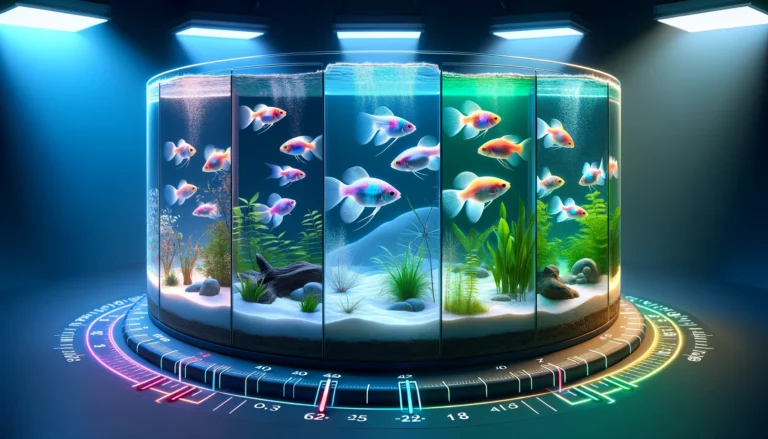Breeding GloFish: A Comprehensive Guide for Success
GloFish are not just any fish. They are vibrant, colorful, and a favorite in the world of aquariums. Originating from the modification of genes, these fish glow under black lights. This unique trait has made them extremely popular among aquarium enthusiasts. Their bright colors come in various shades: pink, green, orange, and more. This variety adds an extraordinary aesthetic to any tank.
Aquarists love GloFish for more than their colors. These fish are also known for their hardiness, making them suitable for beginners. They can adapt to various tank conditions, making them a practical choice for many. Their active behavior and schooling nature provide endless entertainment. Aquariums with GloFish are not just tanks; they are living, glowing art pieces.
Why Breed GloFish and What Varieties are Available
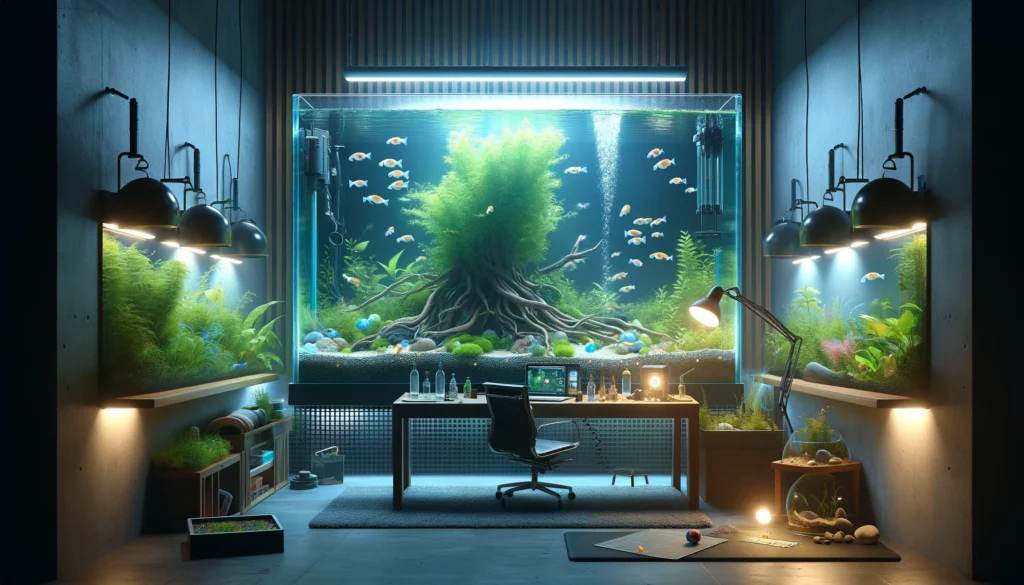
Breeding GloFish can be a rewarding experience. It’s not just about increasing the number of your fish. It’s about understanding and participating in the life cycle of these unique creatures. For enthusiasts, breeding GloFish is a hobby that brings satisfaction and a deeper connection with their aquatic pets.
There are ethical considerations too. Breeding your GloFish can reduce the demand on wild populations. This practice promotes sustainability and conservation in the aquarium trade. By breeding GloFish, you contribute to the ethical treatment of these creatures.
Available varieties of GloFish are quite diverse. Each type offers its unique flair and behavior. You can choose from GloFish Tetras, Barbs, Danios, and more. Each species has specific needs and behaviors. For instance, Tetras are great for community tanks, while Barbs are more semi-aggressive. Knowing each type helps in creating a harmonious tank. It also makes the breeding process more predictable and enjoyable.
In conclusion, GloFish are more than just colorful pets. They are a gateway to a more engaging, responsible, and fulfilling hobby. Whether you’re a seasoned aquarist or a curious beginner, the world of GloFish offers endless possibilities. From the joy of watching them glow to the satisfaction of breeding, these fish make every aquarium a spectacle to behold.
Preparing the Aquarium
Aquarium Size and Characteristics

When you decide to breed GloFish, the first step is setting up the right aquarium. The size of the aquarium is crucial. For GloFish, a tank that holds at least 20 gallons is a good start. This gives enough space for the fish to swim and breed comfortably. The shape of the tank also matters. Longer tanks are better than taller ones, as they provide more swimming area. Ensure the tank has a lid, as GloFish might jump out.
Filters are essential for maintaining clean water. But, the current should be gentle to not stress the fish or disturb the eggs. A gentle filter ensures the water stays clean without causing strong currents. A heater is also necessary. It maintains a consistent temperature in the tank. Lighting is more for viewing pleasure, but it should replicate natural day cycles.
Appropriate Water Parameters for Breeding GloFish
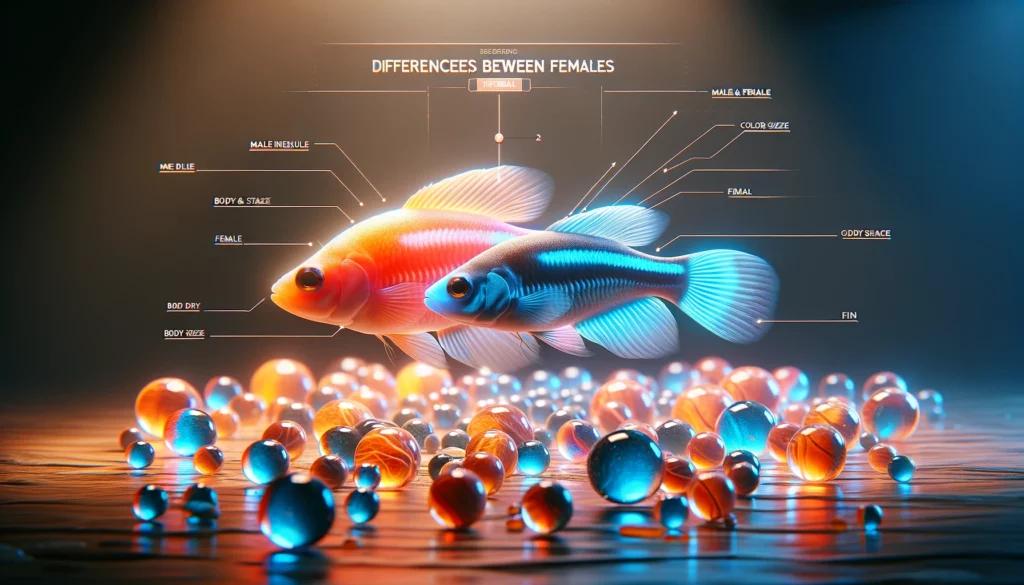
Water parameters are vital for the health and breeding success of GloFish. The water must be kept clean and at the right conditions. The temperature should be between 72°F and 80°F. GloFish thrive in this range, and it encourages breeding. The pH level is another critical factor. It should be between 6.5 and 7.5. Regularly test the water to ensure these levels are maintained.
Water hardness should be moderate. The general hardness (GH) should range from 4 to 10 dGH. The carbonate hardness (KH) should be between 3 and 8 dKH. These levels keep the water stable and healthy for GloFish. Ammonia, nitrite, and nitrate levels should be monitored. They should be as low as possible. High levels are toxic and can hinder breeding or harm the fish. Regular water changes, about 25% weekly, help maintain these parameters.
In summary, preparing the aquarium is a mix of getting the right size, ensuring the tank setup supports the needs of GloFish, and maintaining water quality. This creates a conducive environment for your GloFish to not just live, but thrive and breed.
Selecting Parent Fish
Choosing Healthy and Suitable Parent Fish
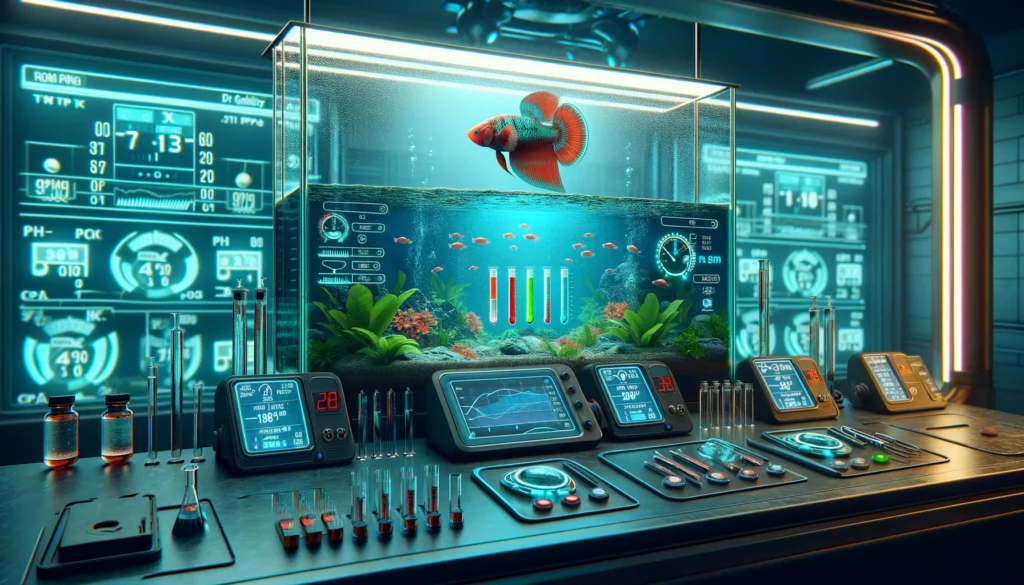
Selecting the right parent fish is vital for successful breeding. Look for active and vibrant GloFish. Healthy fish display bright colors and have clear eyes. They are active, eat well, and don’t show signs of diseases like white spots, fuzzy patches, or ragged fins.
The age of the fish also matters. Choose young adults as they are in their prime breeding time. Fish that are too young or too old might not breed successfully. Observe the fish in your tank. Choose those that interact well. GloFish that are aggressive or overly shy might not be suitable for breeding.
Differences Between Males and Females
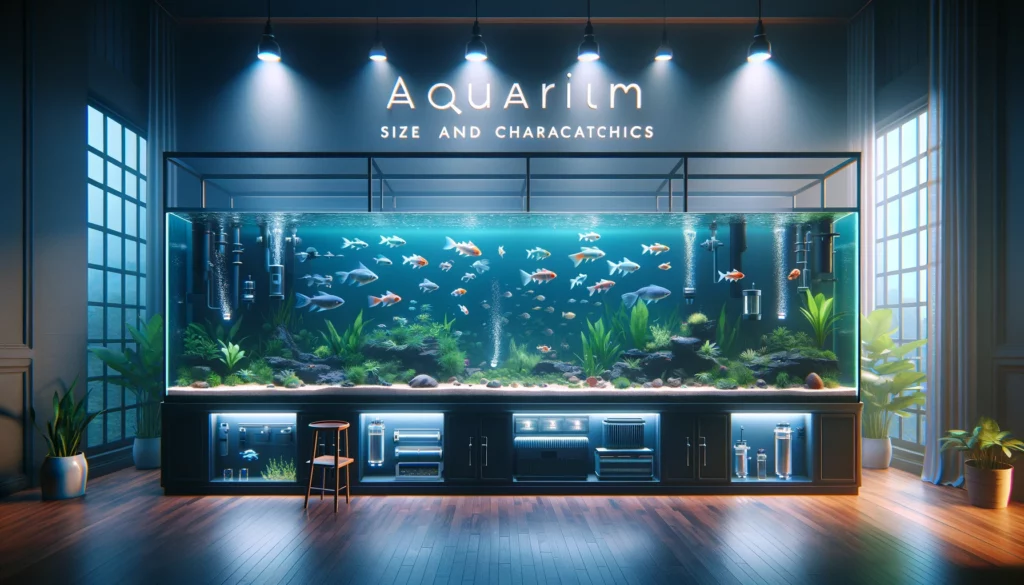
Knowing the sex of your GloFish is essential for breeding. Male and female GloFish have distinct differences. In many species, males are slimmer and brighter. Females are often rounder and fuller, especially when ready to breed as their bellies swell with eggs.
In some GloFish species, the differences are more subtle. For instance, in GloFish Tetras, males have a small, pointed anal fin. Females have a larger, rounded anal fin. Observing these differences takes a keen eye and some experience.
It’s also beneficial to have more females than males in the breeding tank. This reduces stress on the females during the breeding process. A general ratio is two females for every male. This ensures that no single fish is overburdened by the attention of the others.
| Aspect | Male GloFish | Female GloFish |
|---|---|---|
| Physical Differences | Slimmer and brighter | Rounder and fuller, especially when ready to breed |
| Anal Fin | Small, pointed anal fin | Larger, rounded anal fin |
| GloFish Tetras Example | Yes | Yes |
| Ideal Ratio in Tank | More females than males (2:1) | – |
| Key Factors for Breeding | Healthy, breeding age, properly sexed | – |
In conclusion, selecting the right parent fish involves ensuring they are healthy, of breeding age, and properly sexed. This sets the stage for a successful breeding environment. A harmonious balance in the tank, with the right male to female ratio, contributes to effective breeding.
Creating Conditions for Breeding
Temperature and Lighting in the Aquarium
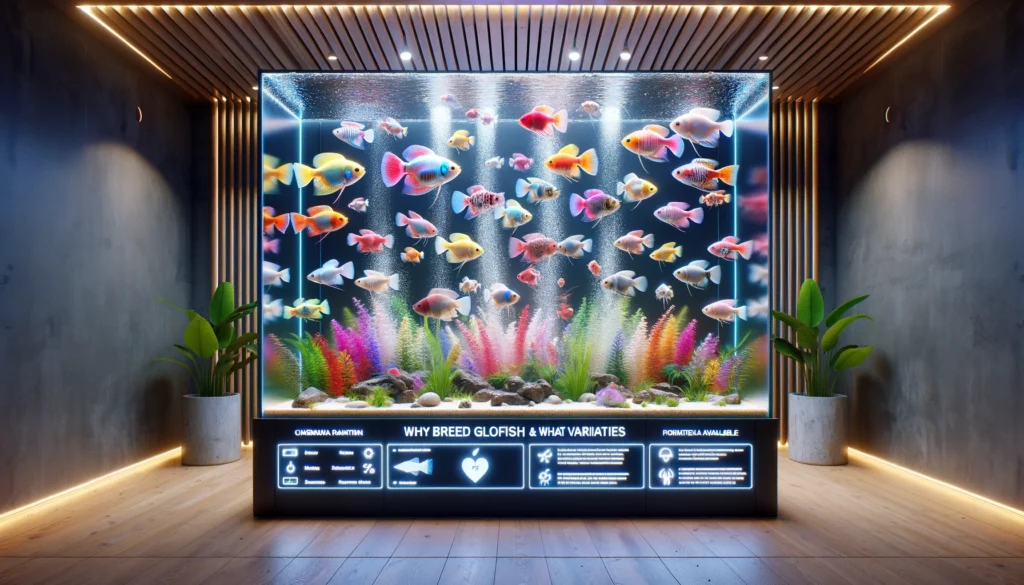
For breeding GloFish, maintaining the right temperature and lighting is crucial. The ideal temperature for GloFish breeding ranges from 78°F to 80°F. This slightly warmer temperature encourages spawning behavior. It’s important to use a reliable aquarium heater and regularly check the temperature with a thermometer.
Lighting also plays a significant role. GloFish are accustomed to regular day and night cycles. Mimicking these natural conditions in your aquarium can help stimulate breeding. A standard practice is to provide 12 hours of light and 12 hours of darkness. This can be easily managed with a timer for your aquarium lights. Ensure the light is not too intense as GloFish prefer subdued lighting.
Setting Up a Breeding Ground

Creating a comfortable environment for egg laying is essential. Provide ample hiding spots and soft substrates. Fine-leaved plants or breeding mops are ideal. They offer places for the fish to spawn and for the eggs to attach.
If you’re breeding egg-scattering species of GloFish, consider a breeding tank with a mesh or a perforated bottom. This allows the eggs to fall through, away from the parents, preventing them from eating the eggs. The tank should be kept clean, and the water parameters should be monitored closely during this period. After spawning, you might need to remove the parents to protect the eggs from being eaten.
In summary, creating the right conditions for breeding involves adjusting the temperature and lighting to encourage spawning and setting up a safe and comfortable breeding ground for egg laying and development. With the right setup, your GloFish can successfully breed and provide you with a new generation of vibrant fish.
Breeding Period
Identifying Readiness for Breeding
Understanding when GloFish are ready to breed is key. Look for behavioral signs. When ready, males often display more vibrant colors. They may also show more interest in females, following them around the tank. Females might appear fuller or rounder. This indicates they carry eggs. Both sexes might clean a spot in the tank, preparing it for eggs.
Another sign is increased appetite. GloFish ready to breed often eat more. This energy supports the breeding process. Watch for these signs. They indicate your fish are in the breeding mood. The right tank conditions can encourage this behavior. Make sure the environment is optimal for breeding.
Observing the Breeding Process and Signs of Success
Breeding in GloFish can be subtle or overt, depending on the species. Observation is crucial. Some GloFish scatter their eggs, while others may lay them in a specific spot. After laying eggs, some species guard them, while others show no interest.
After breeding, look for eggs. They are tiny and can be hard to spot. A magnifying glass might help. If you see eggs, it’s a sign of success. Keep the tank conditions stable. This ensures the eggs develop properly.
| Aspect | Observing Breeding in GloFish |
|---|---|
| Breeding Variability | Subtle or overt, depending on species |
| Egg Disposition | Some scatter, some lay in specific spots |
| Egg Protection | Some species guard eggs, others show no interest |
| Identifying Eggs | Tiny and may require a magnifying glass |
| Sign of Success | Presence of eggs is a positive sign |
| Tank Conditions | Maintain stable conditions for proper egg development |
| Post-Breeding Behavior of Parent Fish | Varies by species; some may eat eggs, while others protect them |
Note the parent fish’s behavior post-breeding. Some might try to eat the eggs. If this happens, you might need to separate them from the eggs. In other cases, parents protect the eggs. Each species is different.
In summary, understanding the signs of readiness and observing the breeding process closely are essential. This helps in ensuring the success of breeding GloFish. With careful observation and maintenance of optimal conditions, you can hope to see a new generation of GloFish in your tank soon.
Caring for Eggs and Fry
Feeding and Caring for the Fry
Once the GloFish eggs hatch, the tiny fry need proper care to survive and grow. Feeding them the right food is crucial. Initially, fry are too small for regular fish food. They can eat infusoria, newly hatched brine shrimp, or commercial fry food. These are small enough for the fry to eat and nutritious.
Feed the fry small amounts several times a day. Overfeeding can pollute the water, leading to health issues. Clean, oxygen-rich water is vital for the fry. Regular partial water changes are necessary. However, be gentle to not disturb the fry. A sponge filter is ideal for fry tanks. It cleans the water without creating strong currents.
Avoiding Potential Problems and Diseases
Fry are vulnerable to diseases and environmental stress. Maintain optimal tank conditions to prevent issues. Keep the water clean and at the right temperature. Poor water quality can lead to diseases like fungus or ich.
Monitor the fry for signs of distress or illness. These include lack of movement, not eating, or spots on the body. If you notice any of these, isolate the affected fry and treat the water. Quarantine helps prevent the spread of diseases.
| Aspect | Avoiding Problems and Diseases in GloFish Fry |
|---|---|
| Maintaining Tank Conditions | – Keep water clean and at the right temperature |
| Potential Diseases | – Poor water quality can lead to diseases like fungus or ich |
| Monitoring for Distress/Illness | – Observe fry for lack of movement, not eating, or body spots |
| Isolation and Treatment | – Isolate affected fry and treat the water if necessary |
| Overcrowding | – Avoid overcrowding, provide enough space as fry grow |
| Regular Water Parameter Check | – Check and maintain water parameters for stability |
Avoid overcrowding. As the fry grow, they need more space. Overcrowding can lead to stress and health problems. Be ready to move some to another tank if needed. Regularly check the water parameters. Stability is key for the healthy growth of fry.
In summary, careful feeding, maintaining water quality, and monitoring for health issues are essential in caring for GloFish fry. With the right care, these tiny creatures will grow into healthy, vibrant adults, adding more color and life to your aquarium.
Conclusion: Results of Breeding GloFish
Breeding GloFish can be a rewarding experience. Witnessing the cycle of life from eggs to fry (baby fish) in your aquarium is fascinating. Success in breeding GloFish comes from attention to detail and consistent care. The vibrant colors and unique glow of GloFish make the breeding process even more exciting.
After successful breeding and nurturing of the fry, you’ll notice growth and color development. This is a sign of your success. The proper care, right feeding, and maintenance of water quality all contribute to the healthy development of GloFish fry.
Tips and Recommendations for Successful Breeding
- Patience is key. Breeding GloFish, like any fish, requires time and attention.
- Regular monitoring of water parameters ensures a healthy environment for breeding and fry development.
- Quality food and proper feeding routines are crucial for both adults and fry.
- Be prepared for challenges. Not every breeding attempt may be successful, but each offers learning opportunities.
Share Your Experience and Success
Your journey in breeding GloFish can inspire others. Share your stories, tips, and successes in the comments. Your experience can be a valuable guide for fellow enthusiasts.
Spread the joy of GloFish breeding. Share this post with friends who love aquariums. Encourage them to embark on their breeding adventure. Your experiences and knowledge can help grow the community of GloFish enthusiasts. Leave your questions and comments for discussion. Let’s learn and grow together in this fascinating hobby!



